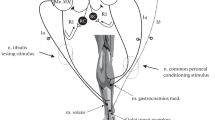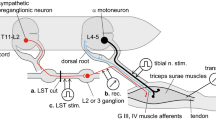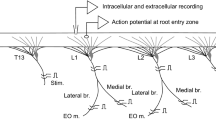Summary
-
1.
The neural mechanisms responsible for contraction of the nerve cord sheath muscles were investigated in the leech,Hirudo medicinalis.
-
2.
Two kinds of cord contractions could be distinguished: one, of small amplitude and slow time course, is not preceded by discharge of the fast conducting system (FCS); the second has higher amplitude and faster time course and is always preceded by the discharge of the FCS (Fig. 2).
-
3.
Electric stimulation of the nerve cord before and after selective lesions of Faivre's nerve or of the lateral connectives showed that “generalized” shortening of the nerve cord involving all the connectives requires firing of an intact FCS. Only “local” shortening, limited to the two connectives adjacent to the stimulating electrode, can be elicited after lesion of the FCS (Figs. 3, 4, 5).
-
4.
Impulse discharge of the primary mechanoceptive neurons T, P, and N causes local shortening without FCS firing. Firing of the T cell at a rate sufficient to activate the FCS transsynaptically, is always followed by generalized cord contraction (Fig. 6).
-
5.
Increases or decreases in the firing rate of the L motoneurone, either spontaneously occurring or experimentally imposed by altering its membrane potential, are consistently followed by contractions and relaxations of the nerve cord, respectively (Fig. 8).
-
6.
Single FCS action potentials are followed by all-or-none depolarizing PSPs in the L motoneurone, at a latency of less than 1 ms, and are able to fire the cell. After a single potential is fired by the FCS, the PSPs appearing in the L motoneurons located in different ganglia are separated by a latency corresponding to the conduction time of the FCS (Figs. 9, 10, 11). The PSPs are Mg++ resistant and are increased by hyperpolarization and decreased by depolarization of the post-synaptic membrane (Figs. 12, 13).
-
7.
It is concluded that the L motoneurone, which subserves body shortening, innervates also the muscle cells of the cord sheath and that the rôle of the FCS is to bring about the generalization of both body and cord shortening reflexes.
Similar content being viewed by others
Abbreviations
- FCS:
-
fast conducting system
References
Bagnoli, P., Brunelli, M., Magni, F.: A fast conducting pathway in the C.N.S. of the leech,Hirudo medicinalis. Arch. ital. Biol.110, 35–51 (1972)
Bagnoli, P., Brunelli, M., Magni, F.: Afferent connections to the fast conduction pathway in the C.N.S. of the leech,Hirudo medicinalis. Arch. ital. Biol.111, 58–75 (1973)
Bagnoli, P., Brunelli, M., Magni, F., Pellegrino, M.: Suprasegmental inputs to the fast conducting system ofHirudo medicinalis. Arch. ital. Biol.112, 307–329 (1974)
Bagnoli, P., Brunelli, M., Magni, F., Pellegrino, M.: The neuron of the F.C.S. inHirudo medicinalis: identification and synaptic connections with primary afferent neurons. Arch. ital. Biol.113, 21–43 (1975)
Baylor, D.A., Nicholls, J.G.: Chemical and electrical synaptic connections between cutaneous mechanoreceptor neurons in the CNS of the leech. J. Physiol. (Lond.)203, 591–609 (1969)
Frank, E., Jansen, J.K.S., Rinvik, E.: A multisomatic axon in the central nervous system of the leech. J. comp. Neurol.159, 1–4 (1975)
Gardner-Medwin, A.R., Jansen, J.K.S.. Taxt, T.: The “giant” axon of the leech. Acta physiol. scand.87, 30A-31A (1973)
Gee, W.: The behavior of leeches with especial reference to its modifiability. Univ. Calif. Publ. Zool.11, 197–305 (1912)
Jansen, J.K.S., Muller, K.J., Nicholls, J.G.: Persistent modification of synaptic interactions between sensory and motor nerve cells following discrete lesions in the central nervous system of the leech. J. Physiol. (Lond.)242, 289–305 (1974)
Kuffler, S.W., Nicholls, J.G.: From neuron to brain. Sunderland, Massachusetts: Sinauer Associates 1976
Laverack, M.S.: Mechanoreceptors, photoreceptors and rapid conduction pathway in the leech,Hirudo medicinalis. J. exp. Biol.50, 129–140 (1969)
Magni, F., Pellegrino, M.: Nerve cord shortening induced by activation of the fast conducting system in the leech. Brain Res.90, 169–174 (1975)
Mistick, D.: Rohde's fiber: a septate axon in the leech. Brain Res.74, 342–348 (1974)
Muller, K.J., McMahan, U.J.: The shapes of sensory and motor neurones and the distribution of their synapses in ganglia of the leech: a study using intracellular injection of horseradish peroxidase. Proc. roy. Soc. B194, 481–499 (1976)
Nicholls, J.G., Baylor, D.A.: Specific modalities and receptive fields of sensory neurons in CNS of the leech. J. Neurophysiol.31, 740–756 (1968)
Nicholls, J.G., Purves, D.: Monosynaptic chemical and electrical connections between sensory and motor cells in the CNS of the leech. J. Physiol. (Lond.)209, 647–667 (1970)
Sandeman, C.D.: A sensitive position measuring device for biological systems. Comp. Biochem. Physiol.24, 635–638 (1968)
Stuart, A.E.: Physiological and morphological properties of moto-neurones in the central nervous system of the leech. J. Physiol. (Lond.)209, 627–647 (1970)
Tulsi Ram, S., Coggeshall, R.E.: Neuromuscular junctions on the muscle cells in the CNS of the leechHirudo medicinalis. J. comp. Neurol.141, 1–16 (1971)
Author information
Authors and Affiliations
Additional information
The Authors wish to express their indebtness to Dr. W.D. Willis jr. for critically reading the manuscript. The expert technical assistance of Mr. A. Bertini and Mrs. Bruna Margheritti is acknowledged with thanks.
Rights and permissions
About this article
Cite this article
Magni, F., Pellegrino, M. Neural mechanisms underlying the segmental and generalized cord shortening reflexes in the leech. J. Comp. Physiol. 124, 339–351 (1978). https://doi.org/10.1007/BF00661383
Accepted:
Issue Date:
DOI: https://doi.org/10.1007/BF00661383




